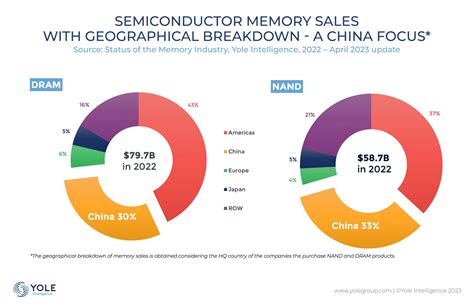
China’s leading memory chip manufacturer, ChangXin Memory Technologies (CXMT), is reportedly bypassing further development of DDR4 memory and moving directly to DDR5, a decision fueling speculation about Beijing’s influence in bolstering domestic technological advancements amid ongoing geopolitical tensions. The move positions CXMT to potentially leapfrog competitors and aligns with China’s broader strategy to achieve self-sufficiency in critical technology sectors.
ChangXin Memory Technologies (CXMT), China’s foremost DRAM manufacturer, is strategically pivoting away from sustained investment in DDR4 memory technology, opting instead to focus its resources on the advancement and production of DDR5. This bold decision, according to industry analysts, underscores China’s determined push to attain technological self-reliance and to diminish its dependency on foreign semiconductor suppliers, particularly in light of escalating trade tensions and technology restrictions imposed by the United States and its allies. This shift could significantly alter the competitive landscape of the global memory market, particularly if CXMT can successfully scale DDR5 production and compete on price and performance.
The decision to eschew further DDR4 development in favor of DDR5 represents a calculated risk for CXMT. DDR4 remains a widely used and mature technology, prevalent in a significant portion of existing computer systems and servers. Abandoning further optimization and expansion in this area could leave a gap in CXMT’s product portfolio. However, the strategic rationale is clear: DDR5 offers superior performance, increased bandwidth, and improved energy efficiency compared to its predecessor, making it the memory standard of the future. By concentrating on DDR5, CXMT aims to position itself at the forefront of memory technology, capturing a larger share of the high-end market and reducing its reliance on older, less profitable technologies.
This strategic realignment is not occurring in a vacuum. It is deeply intertwined with China’s national policy objectives, specifically the “Made in China 2025” initiative and related efforts to bolster domestic semiconductor manufacturing capabilities. The Chinese government has been actively investing in its semiconductor industry, providing substantial financial support, tax incentives, and policy guidance to companies like CXMT. The goal is to create a robust and self-sufficient ecosystem that can meet China’s growing demand for advanced semiconductors, ranging from memory chips to processors and other critical components.
The potential impact of CXMT’s decision on the global memory market is substantial. Currently, the DRAM market is dominated by a few major players, including Samsung, SK Hynix, and Micron. These companies have invested heavily in both DDR4 and DDR5 technologies, and they hold significant market share. If CXMT can successfully develop and produce competitive DDR5 memory chips, it could disrupt the existing market dynamics, potentially driving down prices and increasing competition. This could benefit consumers and businesses by making advanced memory technology more accessible.
However, challenges remain for CXMT. Developing and manufacturing advanced memory chips is a complex and capital-intensive undertaking. CXMT will need to overcome significant technological hurdles, including refining its manufacturing processes, improving chip yields, and ensuring compatibility with a wide range of computer systems and devices. Furthermore, the company will need to navigate intellectual property issues and potential trade restrictions that could hinder its access to key technologies and equipment.
The broader context of geopolitical tensions between China and the United States also plays a crucial role. The US government has imposed export controls on certain semiconductor technologies and equipment, restricting the ability of Chinese companies to acquire the tools and expertise needed to advance their semiconductor manufacturing capabilities. These restrictions could potentially slow down CXMT’s progress and limit its ability to compete effectively in the global market.
Despite these challenges, CXMT’s decision to focus on DDR5 reflects a strategic and ambitious vision. It underscores China’s determination to become a leader in the semiconductor industry and to reduce its reliance on foreign technology. Whether CXMT can successfully achieve this goal remains to be seen, but its efforts will undoubtedly have a significant impact on the future of the global memory market and the broader technology landscape. The company’s progress will be closely watched by industry analysts, policymakers, and competitors alike.
The move to DDR5 also highlights the growing importance of advanced memory technologies in enabling emerging applications such as artificial intelligence, high-performance computing, and data analytics. These applications require memory chips with high bandwidth, low latency, and high capacity. DDR5 offers significant improvements in these areas compared to DDR4, making it the preferred memory standard for these demanding workloads. By focusing on DDR5, CXMT is positioning itself to capitalize on the growth of these emerging markets and to meet the evolving needs of its customers.
Furthermore, CXMT’s shift could incentivize other Chinese semiconductor companies to accelerate their own development efforts in advanced memory technologies. This could lead to a broader strengthening of China’s domestic semiconductor ecosystem and further reduce its reliance on foreign suppliers. The Chinese government is likely to continue providing strong support to these companies, recognizing the strategic importance of the semiconductor industry to its economic and national security.
The transition to DDR5 is not without its challenges for the broader ecosystem as well. While DDR5 offers numerous advantages, it also requires new infrastructure and supporting technologies. Motherboard manufacturers, chipset designers, and software developers all need to adapt to the new memory standard. This transition takes time and investment, and it could potentially create bottlenecks in the adoption of DDR5.
Moreover, the cost of DDR5 memory is currently higher than DDR4, which could limit its adoption in price-sensitive markets. As production volumes increase and manufacturing processes improve, the cost of DDR5 is expected to decline, making it more accessible to a wider range of users. However, the price premium could remain a factor in the short term, particularly in developing countries where cost is a major consideration.
In conclusion, CXMT’s decision to prioritize DDR5 over further DDR4 development is a strategic move that reflects China’s broader ambitions in the semiconductor industry. While challenges remain, the company’s efforts have the potential to reshape the global memory market and to contribute to China’s goal of achieving technological self-reliance. The implications of this decision will be felt across the technology landscape, from memory chip manufacturers to computer system vendors and end users. It is a development that warrants close attention and further analysis.
The move aligns with the broader trend of technological decoupling, where countries are seeking to reduce their reliance on foreign suppliers and to build their own domestic capabilities in critical technology sectors. This trend is being driven by a combination of factors, including geopolitical tensions, supply chain vulnerabilities, and the desire to promote economic growth and innovation. CXMT’s focus on DDR5 is a clear example of this trend in action, and it is likely to be followed by similar moves in other areas of the semiconductor industry.
The success of CXMT’s DDR5 strategy will depend on a number of factors, including its ability to overcome technological challenges, navigate intellectual property issues, secure access to key equipment and materials, and compete effectively in the global market. The company will also need to build strong relationships with its customers and partners to ensure that its DDR5 memory chips are widely adopted.
The impact of CXMT’s decision on the major DRAM manufacturers – Samsung, SK Hynix, and Micron – will also be significant. These companies will need to adapt to the changing competitive landscape and to ensure that they maintain their technological leadership in the memory market. They may also need to reassess their strategies for the Chinese market, taking into account the growing strength of domestic players like CXMT.
Ultimately, CXMT’s focus on DDR5 represents a bold and ambitious move that could have far-reaching consequences for the global memory market and the broader technology industry. It is a development that deserves careful attention and further analysis. The world is watching to see if CXMT can deliver on its promise and become a major player in the advanced memory market. The stakes are high, and the outcome will have a significant impact on the future of technology.
The decision also serves as a potent symbol of China’s increasing assertiveness in the technology sector. No longer content to be a follower, China is actively seeking to become a leader in key technologies, and semiconductors are at the forefront of this effort. CXMT’s DDR5 push is a testament to this ambition and underscores the growing importance of China as a technological powerhouse.
Moreover, the move necessitates a reassessment of global supply chains and the potential for diversification. Companies worldwide are becoming increasingly aware of the risks associated with relying on single sources for critical components. CXMT’s emergence as a potential major player in the DRAM market could offer an alternative supply source, potentially mitigating some of these risks. However, it also introduces new complexities, as companies must navigate the geopolitical landscape and potential trade restrictions.
The technical specifications of DDR5 memory further underscore the significance of CXMT’s move. DDR5 boasts significantly higher bandwidth compared to DDR4, allowing for faster data transfer rates and improved system performance. It also operates at a lower voltage, resulting in increased energy efficiency. These improvements are crucial for demanding applications such as artificial intelligence, high-performance computing, and gaming. By focusing on DDR5, CXMT is positioning itself to cater to the growing demand for these advanced technologies.
Furthermore, the architectural advancements in DDR5 memory contribute to its superior performance. DDR5 incorporates features such as on-die error correction and improved channel efficiency, which enhance reliability and reduce latency. These features are essential for ensuring the stability and responsiveness of modern computer systems. CXMT’s ability to master these architectural complexities will be a key factor in its success.
The economic implications of CXMT’s DDR5 strategy are also noteworthy. A successful push into the advanced memory market could generate significant revenue for the company and contribute to China’s overall economic growth. It could also create new jobs and opportunities in the semiconductor industry, further strengthening China’s technological ecosystem. However, the high capital expenditure required to develop and manufacture DDR5 memory poses a significant challenge. CXMT will need to secure substantial funding and manage its resources effectively to achieve its goals.
The regulatory environment also plays a crucial role in shaping CXMT’s prospects. Government policies, trade regulations, and intellectual property laws can all have a significant impact on the company’s ability to compete in the global market. CXMT will need to navigate these complex regulatory issues carefully to ensure that it complies with all applicable laws and regulations.
In addition, CXMT’s decision to prioritize DDR5 development raises questions about the future of DDR4 memory. While DDR4 remains a widely used and mature technology, its long-term prospects are uncertain. As DDR5 becomes more affordable and widely adopted, demand for DDR4 is likely to decline. This could create challenges for companies that are heavily invested in DDR4 manufacturing. However, DDR4 is likely to remain relevant for many years to come, particularly in cost-sensitive applications and legacy systems.
The competitive landscape in the DRAM market is also evolving rapidly. New players are emerging, and existing players are investing heavily in research and development. CXMT will need to stay ahead of the curve to maintain its competitive edge. This requires a continuous focus on innovation, efficiency, and customer satisfaction.
The availability of skilled labor is another critical factor in CXMT’s success. Developing and manufacturing advanced memory chips requires a highly skilled workforce with expertise in areas such as semiconductor physics, materials science, and manufacturing engineering. CXMT will need to attract and retain top talent to ensure that it has the expertise needed to compete effectively.
The environmental impact of memory chip manufacturing is also becoming an increasingly important consideration. The production of semiconductors requires significant amounts of energy and water, and it can generate hazardous waste. CXMT will need to adopt sustainable manufacturing practices to minimize its environmental footprint.
In summary, CXMT’s decision to focus on DDR5 represents a significant turning point in the global memory market. It is a bold and ambitious move that reflects China’s growing technological prowess and its determination to become a leader in the semiconductor industry. While challenges remain, the company’s efforts have the potential to reshape the competitive landscape and to contribute to China’s economic and national security. The world is watching to see if CXMT can deliver on its promise and become a major player in the advanced memory market. The outcome will have far-reaching consequences for the technology industry and the global economy.
The shift also underscores the ongoing strategic competition between the United States and China in the technology sector. Both countries recognize the importance of semiconductors to their economic and military strength, and they are investing heavily in their domestic semiconductor industries. CXMT’s DDR5 push is a clear example of this competition in action. The outcome of this competition will have a significant impact on the future of technology and the global balance of power.
Finally, CXMT’s decision has implications for the broader electronics industry. As memory chips become more advanced and efficient, they will enable new applications and innovations in areas such as mobile computing, data centers, and artificial intelligence. CXMT’s success in developing DDR5 memory could accelerate the adoption of these technologies and drive economic growth.
In conclusion, ChangXin Memory Technologies’ strategic pivot to DDR5 is a multifaceted development with significant technological, economic, geopolitical, and environmental implications. Its success hinges on overcoming numerous challenges but holds the potential to reshape the global memory market and solidify China’s position as a key player in the semiconductor industry. The industry will be closely monitoring CXMT’s progress in the coming years.
Frequently Asked Questions (FAQ)
1. Why is CXMT shifting its focus from DDR4 to DDR5 memory technology?
CXMT is strategically shifting its focus to DDR5 to align with the future of memory technology, which offers superior performance, increased bandwidth, and improved energy efficiency compared to DDR4. This move positions CXMT to compete in the high-end market and supports China’s goal of technological self-reliance. According to the original article, “China’s top memory chipmaker is expected to skip further investment in DDR4 memory and jump directly to DDR5.” This shift is part of a broader strategy to decrease dependence on foreign semiconductor suppliers amidst escalating trade tensions and technology restrictions.
2. What impact could CXMT’s decision have on the global DRAM market?
If CXMT successfully develops and produces competitive DDR5 memory chips, it could disrupt the existing market dynamics, potentially driving down prices and increasing competition. This could benefit consumers and businesses by making advanced memory technology more accessible. Currently, the DRAM market is dominated by Samsung, SK Hynix, and Micron, and CXMT’s entry could challenge their dominance.
3. What are the main challenges CXMT faces in its pursuit of DDR5 technology?
CXMT faces significant technological hurdles, including refining manufacturing processes, improving chip yields, and ensuring compatibility with various computer systems. The company also needs to navigate intellectual property issues and potential trade restrictions. Developing and manufacturing advanced memory chips is a complex and capital-intensive undertaking. Moreover, US export controls on semiconductor technologies could hinder CXMT’s access to key equipment and expertise.
4. How does the Chinese government’s policy support CXMT’s strategic shift?
The Chinese government has been actively investing in its semiconductor industry, providing substantial financial support, tax incentives, and policy guidance to companies like CXMT. This support aligns with national policy objectives, such as the “Made in China 2025” initiative, aimed at bolstering domestic semiconductor manufacturing capabilities and achieving technological self-sufficiency.
5. What are the potential implications of CXMT’s move for the broader technology industry beyond memory chips?
CXMT’s focus on DDR5 could accelerate the adoption of advanced technologies such as artificial intelligence, high-performance computing, and data analytics, which require memory chips with high bandwidth and low latency. It also signifies China’s increasing assertiveness in the technology sector and highlights the ongoing strategic competition between the United States and China. The move necessitates a reassessment of global supply chains and the potential for diversification, as companies seek to reduce their reliance on single sources for critical components. This can lead to enhanced innovation and efficiency across the electronics industry.









